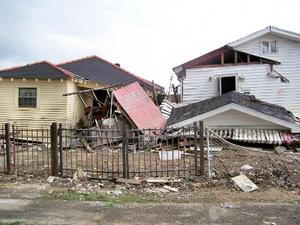InfrastructureGood business: Developers make buildings more disaster-secure than building code requires
A Florida developer hopes to get more business by making his building hurricane-proof; with debris-resistant windows on all thirty-five of its stories, the developer says the building would withstand a Category 5 hurricane without significant damage; the extra hurricane proofing built into the Miami building shows that sometimes the private market can overtake the public sector when it comes to building design and safety standards; for example, in New York and Washington, D.C., some developers have put in anti-terrorism safeguards that exceed building codes

One Florida contractor fights hurricane damage like this by building above the state's building codes // Source: survivalgearsource.com
Meteorologists are warning that this hurricane season could be rougher than usual (“2010 hurricane season is going to be a busy one,” 8 June 2010 HSNW; and “2010 hurricane season unusually active,” 3 June 2010 HSNW), Miami-based developer Alan Ojeda is not too worried. In fact, the hurricane season could turn out to be a marketing opportunity for him.
A. D. Pruitt writes in the Wall Street Journal that in February, Ojeda completed 1450 Brickell Ave., a Miami office tower that he is billing as the first fully hurricane-protected high-rise office building in the state. With debris-resistant windows on all thirty-five of its stories, he says it would withstand a Category 5 hurricane without significant damage.
Local residents commonly refer to Brickell Avenue as “Wall Street of the South,” and some of the office buildings on the avenue suffered extensive damage in 2005 from hurricanes Katrina and Wilma, such as tens of thousands shattered windows.
Pruitt says that it is too soon to tell, however, whether Ojeda is making a sound bet financially. He acknowledged the construction costs of 1450 Brickell were hefty because of the extra hurricane protection. The tower cost $240 million with the windows costing $100 a foot. This is roughly 50 percent higher than normal window installations.
So far the 580,000-square-foot building is still roughly 50 percent-leased, not enough to be deemed a commercial success. Ojeda says he is not charging higher rents than his competitors, as he considers this a long-term investment.
Ojeda is hoping that the added protection will translate into greater demand from tenants. Indeed, the building’s largest firm so far is the law firm Bilzin Sumberg Baena Price & Axelrod, which could not get back into its offices for five days after Hurricane Andrew in 1992, according to John Sumberg, managing partner of law firm Bilzin Sumberg.
“To have your offices in perfect condition, ready to go, and the electricity on after a storm is a big deal,” Sumberg says, who predicted that over time the building will be able to charge higher rents than competitors.
Other tenants at the new tower include J.P. Morgan Chase & Co., Bank of New York Mellon Corp., and HIG Capital.
Pruitt writes that the extra hurricane proofing built into 1450 Brickell shows that sometimes the private market can overtake the public sector when it comes to building design and safety standards. For example, in New York and Washington, D.C., some developers have put in anti-terrorism safeguards that exceed building codes. For instance, developer Larry Silverstein installed in 7 World Trade Center a fireproofing material used to protect the steel structure that is 10 times as adhesive and 50 percent more fire-resistant than required by building codes.
Ojeda says “the code … is not enough.” He told Pruitt that after the hurricanes in 2005, he walked along Brickell and “saw many broken glasses way above 30 feet high.” So, “we said, instead of doing the first 30 feet … let’s do the whole building,” he says. The developer also installed a second generator in the building so employees can continue working even if the city loses electricity.
Ojeda recently completed a residential building that has the same kind of debris-resistant glass. He is working on another office tower near the airport with similar protections, scheduled to be completed in twelve months.
Shattered glass is one of the most menacing of damages in a hurricane. Not only do the wind and rain that get in through broken glass wreak havoc on the office interior, the buildup of air that tries to escape blows the building apart from the inside, a phenomenon called internal pressurization. The flying debris from one building can cause damage to nearby properties.
